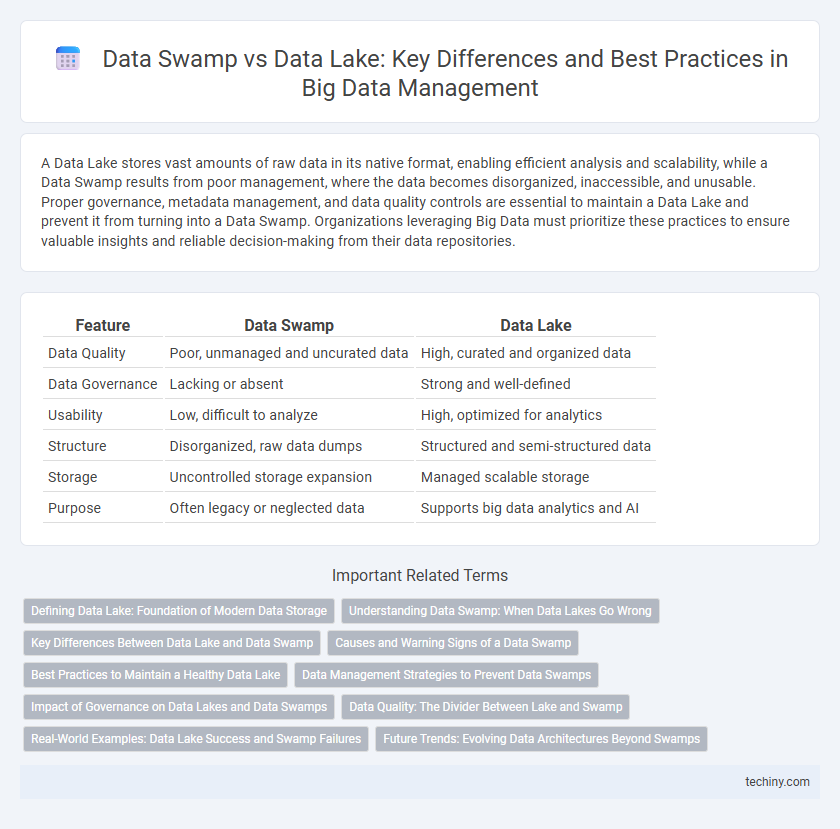A Data Lake stores vast amounts of raw data in its native format, enabling efficient analysis and scalability, while a Data Swamp results from poor management, where the data becomes disorganized, inaccessible, and unusable. Proper governance, metadata management, and data quality controls are essential to maintain a Data Lake and prevent it from turning into a Data Swamp. Organizations leveraging Big Data must prioritize these practices to ensure valuable insights and reliable decision-making from their data repositories.
Table of Comparison
| Feature | Data Swamp | Data Lake |
|---|---|---|
| Data Quality | Poor, unmanaged and uncurated data | High, curated and organized data |
| Data Governance | Lacking or absent | Strong and well-defined |
| Usability | Low, difficult to analyze | High, optimized for analytics |
| Structure | Disorganized, raw data dumps | Structured and semi-structured data |
| Storage | Uncontrolled storage expansion | Managed scalable storage |
| Purpose | Often legacy or neglected data | Supports big data analytics and AI |
Defining Data Lake: Foundation of Modern Data Storage
A Data Lake is a centralized repository designed to store vast amounts of raw, structured, semi-structured, and unstructured data in its native format, enabling scalable analytics and advanced machine learning. Unlike a Data Swamp, which is characterized by poorly managed, disorganized data that lacks quality and governance, a Data Lake emphasizes data integrity, metadata management, and accessibility. This foundational modern data storage architecture supports real-time processing, flexible schema-on-read, and integration with cloud platforms like AWS, Azure, and Google Cloud.
Understanding Data Swamp: When Data Lakes Go Wrong
Data swamps occur when data lakes lack proper governance, metadata management, and data quality controls, causing disorganized, obsolete, or irrelevant data accumulation. This leads to difficulties in data retrieval, analysis, and decision-making, reducing the overall value of the data repository. Effective data governance frameworks and automated metadata tagging are essential to prevent data lakes from becoming data swamps.
Key Differences Between Data Lake and Data Swamp
Data lakes store vast amounts of raw, structured, and unstructured data with proper metadata management, enabling efficient data retrieval and analytics. In contrast, data swamps lack proper governance, metadata, and data quality controls, resulting in disorganized and unusable data repositories. The key differences lie in data organization, accessibility, and management practices that influence their usability for big data analytics.
Causes and Warning Signs of a Data Swamp
A data swamp often develops from poor data governance, lack of metadata management, and inconsistent data quality controls, causing unusable, disorganized data storage. Key warning signs include high data redundancy, difficult data discoverability, and low trust in data accuracy, leading to inefficient analytics. Proactive implementation of data cataloging and rigorous quality checks can prevent data lakes from deteriorating into data swamps.
Best Practices to Maintain a Healthy Data Lake
A healthy data lake requires rigorous metadata management, data quality checks, and governance frameworks to prevent it from degrading into a data swamp. Implementing automated data cataloging, access controls, and continuous monitoring ensures data remains discoverable, trustworthy, and usable for analytics. Adhering to these best practices optimizes data lake performance and supports scalable, efficient big data processing.
Data Management Strategies to Prevent Data Swamps
Effective data management strategies to prevent data swamps include implementing robust metadata management, enforcing data governance policies, and maintaining data quality through regular auditing and cleansing. Leveraging automated data cataloging tools and establishing clear data ownership roles ensure that data lakes remain organized, accessible, and valuable. Integrating these practices minimizes data redundancy, inconsistency, and irrelevance, transforming raw data repositories into actionable insights hubs.
Impact of Governance on Data Lakes and Data Swamps
Effective data governance transforms data lakes into valuable assets by enforcing data quality, metadata management, and access controls, preventing the descent into data swamps. Poor governance results in data swamps characterized by disorganized, inconsistent, and unreliable data, which hampers analytics and decision-making. Strong governance frameworks ensure data lakes maintain integrity, usability, and compliance, maximizing their impact on business intelligence.
Data Quality: The Divider Between Lake and Swamp
Data quality serves as the critical divider between a data lake and a data swamp, where clean, well-governed data in a data lake enables efficient analytics and decision-making, while poor data quality in a data swamp leads to data inconsistencies, redundancy, and unusable information. Effective metadata management and rigorous data governance practices ensure data lakes remain organized and reliable repositories, whereas the absence of these controls causes data lakes to degrade into data swamps. Maintaining high data quality through continuous monitoring and validation prevents data lakes from becoming overwhelmed by raw, uncurated datasets that compromise analytical outcomes.
Real-World Examples: Data Lake Success and Swamp Failures
Data lakes exemplified by companies like Netflix and Amazon enable seamless data integration and advanced analytics, showcasing success in handling vast, diverse datasets through robust governance and metadata management. In contrast, data swamps occur when organizations accumulate raw data without proper cataloging or quality control, leading to wasted resources and analysis paralysis, as seen in failed projects within sectors such as retail and healthcare. Effective implementation of data lakes hinges on strategic architecture and continuous data stewardship to prevent decaying into dysfunctional data swamps.
Future Trends: Evolving Data Architectures Beyond Swamps
Emerging data architectures are moving beyond traditional data lakes to address challenges posed by data swamps, such as poor governance and data quality issues. Future trends emphasize implementing metadata management, automated data cataloging, and machine learning to enhance data discoverability and trustworthiness. These innovations enable organizations to transform vast unstructured data into actionable insights, ensuring scalable and adaptive ecosystems.
Data Swamp vs Data Lake Infographic

 techiny.com
techiny.com